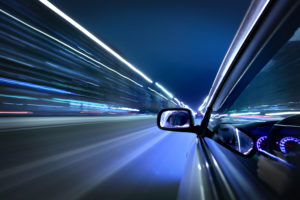The Basic Speed Law in California states drivers may not drive faster than is “reasonable and prudent and in no event at a speed which endangers the safety of persons or property.” So how do you know what is “reasonable and prudent?” As a car accident lawyer, this can be a crucial question in determining who is at-fault for an auto accident.
How CA Speed Limits Are Set
The state’s Vehicle Code establishes “reasonable and prudent” speed limits based on the type of road. For instance the maximum speed is:
- 65 MPH on most California freeways;
- 55 MPH on a two-lane, undivided highway;
- 15 MPH in alleyways, approaching blind intersections and/or at railroad crossings;
- 25 MPH in near schools
But these are not definitive, and are changed by each locality. In addition, weather and traffic can determine what is “reasonable and prudent” on a particular road, at a particular time. Many Californians do not realize they can be ticketed for speeding, even when driving under the speed limit, if road or weather conditions are bad.
For example, according to the California Department of Motor Vehicles, if a driver is going 45 MPH in a 55 MPH zone when there is dense fog, he or she can be cited for speeding.
A driver who travels too fast for the existing conditions, or exceeds the limit, is speeding. He or she is also significantly increasing the chances of causing a car accident. According to the National Highway Traffic Safety Administration, “speeding is one of the most prevalent factors contributing to traffic crashes.”
How Does Speeding Prove Who Was At-Fault for a Car Accident?
When excessive speed is the cause of a motor vehicle accident, the speeding driver is assumed to be at fault for the crash, and liable for accident victims’ injuries. According to California Civil Jury Instructions 418, a jury must find a driver at fault for an accident if he or she violated a statute, regulation or ordinance, and that violation was a “substantial factor” in causing harm.
Unless the at-fault driver can prove there was a reason for violating the law, a jury is told to presume the speeding driver is at fault for the accident. This makes it easier for crash victims to win compensation for their losses.
When no laws have been broken, the person injured in a car accident may need expert witnesses and eyewitnesses to prove who was at fault. When a driver was speeding, however, it is enough to simply show the speed limit law was violated, and the crash occurred because of it.
If there is a question about whether a driver was speeding, an accident reconstruction specialist can use skid marks and other related evidence from the accident scene to determine how fast the car was going. The issuance of a citation for speeding could also be evidence that a driver violated a California law.
How a Long Beach Car Accident Lawyer Can Help
Your Injuries are Personal to Me
People injured in a high speed auto accident often incur serious injuries. The faster cars are traveling when a crash occurs, the greater the force of the collision. The greater the force, the more a body has to absorb, and the more likely that serious or fatal injuries will occur. I represent injured accident victims and the family members of accident victims who were killed. I handle every case personally to make sure you receive the maximum compensation you are entitled to.
Call the Law Office of Michael D. Waks at 888-394-1174 or use the convenient online contact form to schedule a free consultation to speak with a Long Beach car accident lawyer to learn how I can help if you’ve suffered a car accident injury. You will be under no obligation and you will never pay any money unless you recover compensation for your losses.
You can also download my convenient glove box checklist to keep in your car so you will know what to do if you are involved in a collision.
- How to Help Your Loved One Cope with a Spinal Cord Injury - October 27, 2021
- How Can I Prove a Motorist Fell Asleep in Traffic? - October 20, 2021
- Filing a Truck Accident Claim? Avoid These Common Mistakes - October 13, 2021
